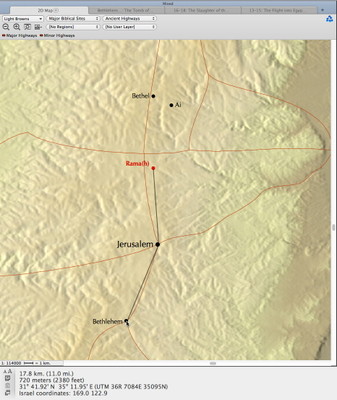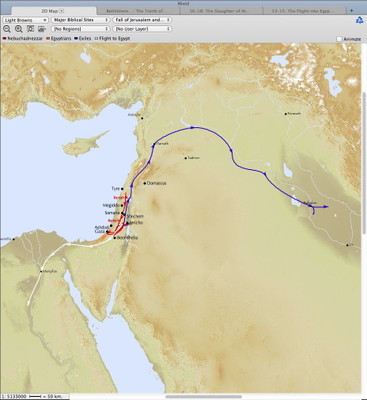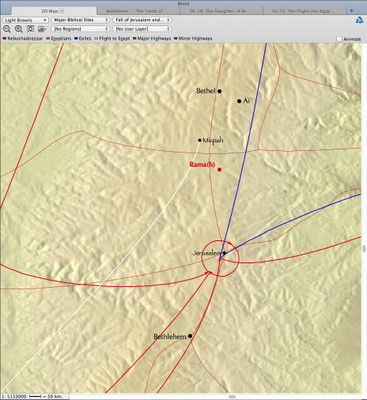In yesterday’s post, I began relating how I used Accordance to teach a Sunday School class on why Matthew saw the slaughter of the innocents at Bethlehem as the “fulfillment” of what Jeremiah wrote about Rachel weeping at Ramah. In that post, we saw that Bethlehem and Ramah, at eleven miles apart, are not exactly neighboring towns. The connection between them is not one of proximity, but of historical memory. Genesis 35 tells us that Rachel died in childbirth on the road from Bethel to Bethlehem, and 1 Samuel appears to indicate that she was buried in the vicinity of Ramah. Thus, Matthew pictures Rachel weeping in her grave at Ramah over the horrific events taking place in Bethlehem—the destination she died looking toward.
In today’s post, I want to look at the original context of Jeremiah’s image of Rachel weeping at Ramah. After all, it was Jeremiah, not Matthew, who first spoke of Rachel weeping there. In Jeremiah’s day, was Rachel weeping over something that had happened in Bethlehem?
To answer that question, I had my Sunday School class look at Jeremiah 31:15-17. Verse 15 contains the lament quoted in Matthew, followed by the LORD‘s command to Rachel to stop weeping. Rachel is comforted with the promise that she will receive the “reward” of her “work,” and her “children will return from the enemy’s land.”
In Jeremiah, Rachel weeps because her children are no more, but this is apparently the result of exile rather than infanticide. I next had my class turn to Jeremiah 40:1, which speaks of Jeremiah being found among the captives being held at Ramah prior to their deportation to Babylon. You see, after the destruction of Jerusalem by the Babylonians, Ramah became the staging area from which the Babylonians actually sent the people of Judah into exile.
To illustrate this for my class, I turned once more to the Accordance Bible Atlas. I changed the Route layer displayed on the Map from Ancient Highways to Fall of Jerusalem and Exile. I then let the animated route play as I explained that the Babylonians attacked Judah not from the east, which would have required taking an army through the desert, but from the north, through Syria and Samaria. They later carried the Jewish captives into the Babylonian exile by the same route.
Wanting to show my class that Ramah was just north of Jerusalem on the main road leading north, I decided to display the Ancient Highways route layer again. Yet I also wanted to show that this was the very route the Babylonians would have taken, so I wanted to keep the Fall of Jerusalem and Exile layer on the map at the same time.
But how to do it? Both of these layers appear in the same pop-up menu of the Atlas, which means choosing one will necessarily remove the other. That is, unless you know the trick! If you hold down the Shift key on your keyboard while selecting a second layer, both layers will be displayed on the map at the same time. So that’s just what I did.
Now I had another problem. When I selected the additional layer, the animation of the Fall of Jerusalem and Exile layer started all over again, and I didn’t want to waste class time waiting for it to finish. So I used another power-user trick: I simply held down the Option key while clicking the Animate checkbox. Doing this skips the animation and immediately shows the finished route. Now I could simply zoom in on the area between Bethel and Bethlehem to show the following.
As you can see, the blue line representing the exiles (see the legend just above the map) does not exactly pass through Ramah or follow the road nearest to Ramah. That’s because most of the animated route layers are designed simply to give a general sense of movement rather than to follow specific roads. Still, it’s easy to see why Ramah would have been used as a staging point for the deportation of the Jerusalem captives.
In this way, Jeremiah imagines Rachel weeping at Ramah because she is watching the deportation of her descendants from the very place where she is buried. In response, the LORD tells her not to weep, because her hope for the future lies in the eventual deliverance and restoration of her children.
As you can see, using the Accordance Bible Atlas really helped to explain the geographical and historical context of these passages. Its flexible interface made it easy to modify the map to show the information I wanted to show, and knowing a few modifier key tricks really helped streamline my presentation.
In my next post, I’ll finish this series by talking about how Matthew connects the story of the slaughter of the innocents to these Old Testament passages (and others) to make his case that Jesus is the long-awaited Messiah.




